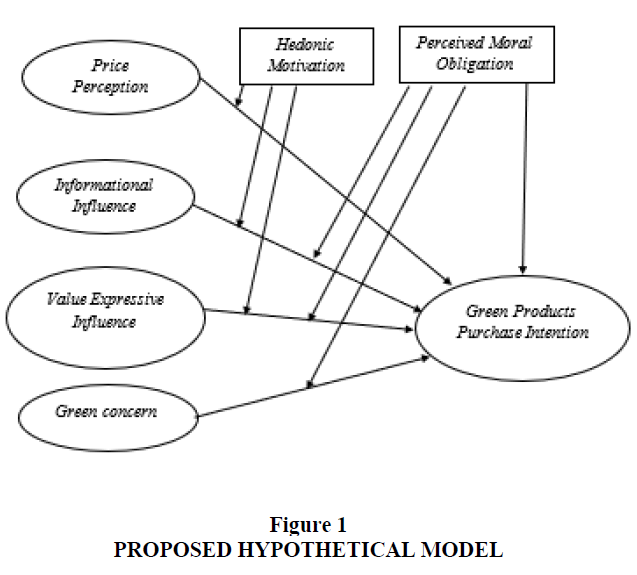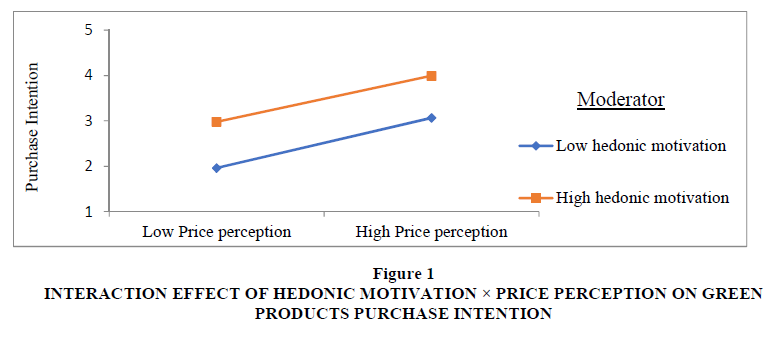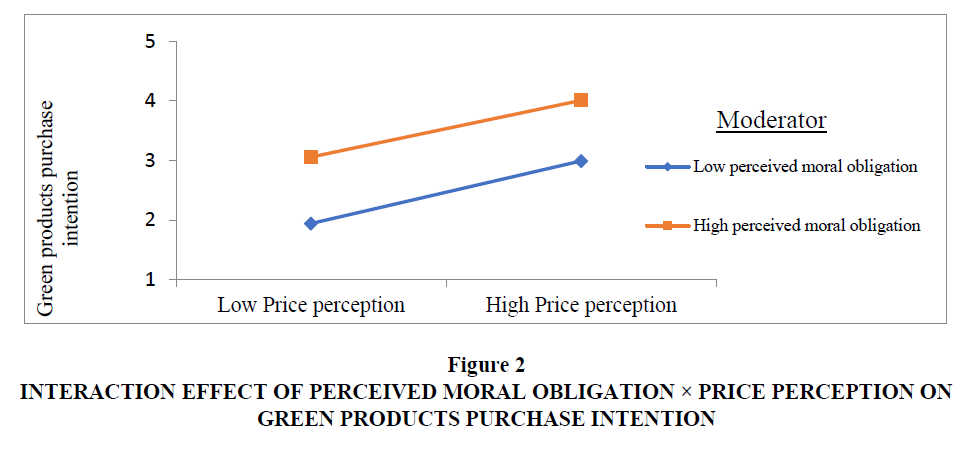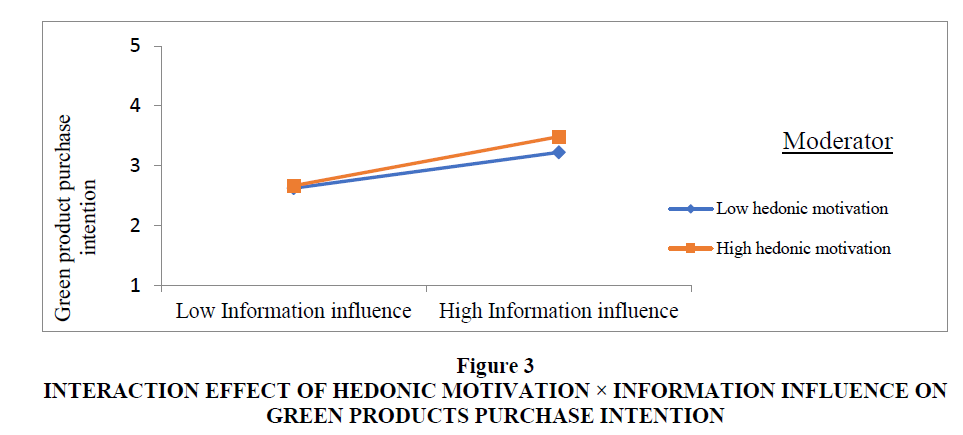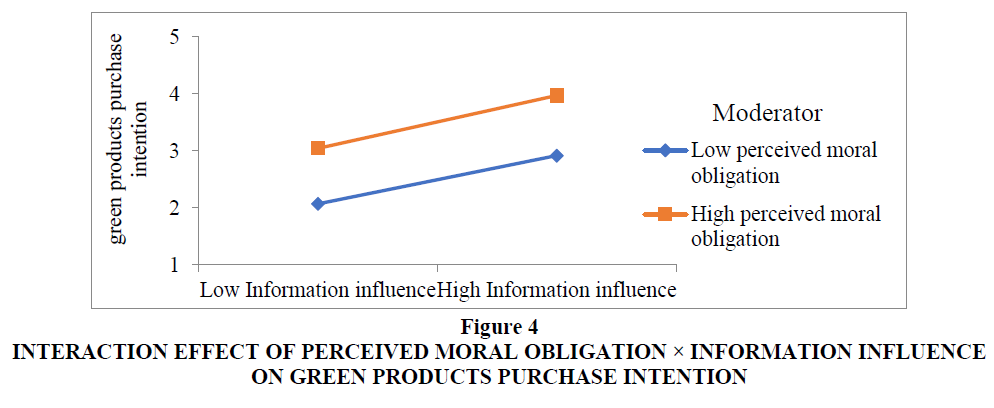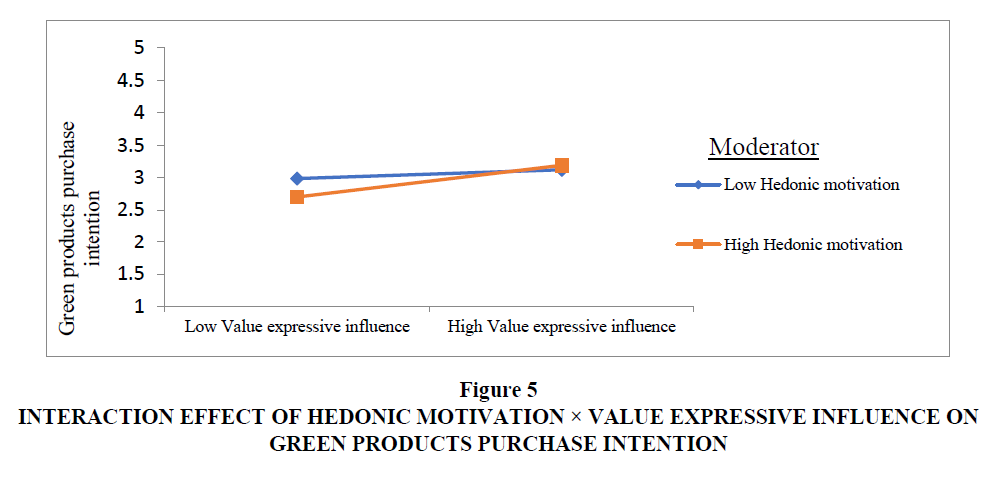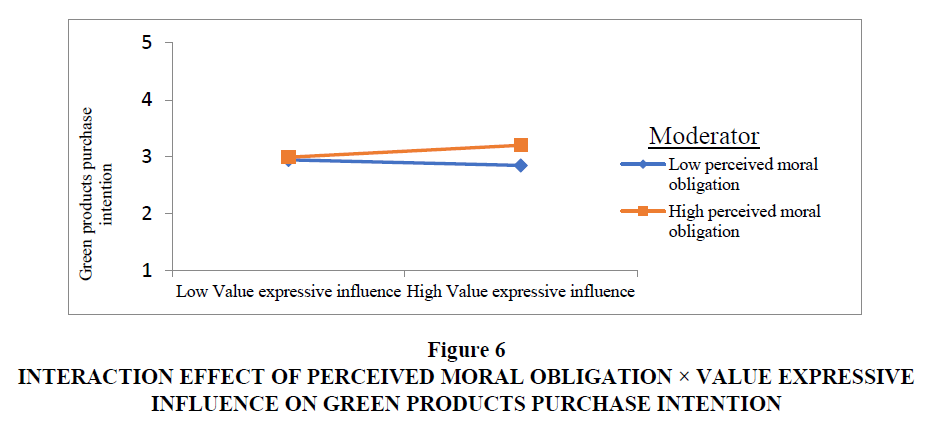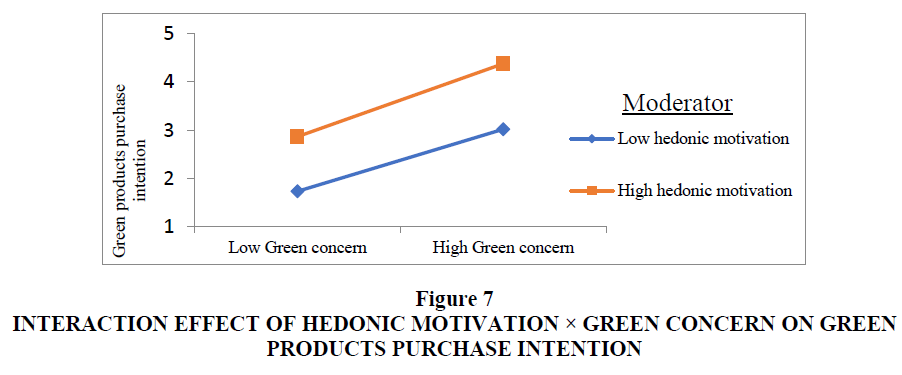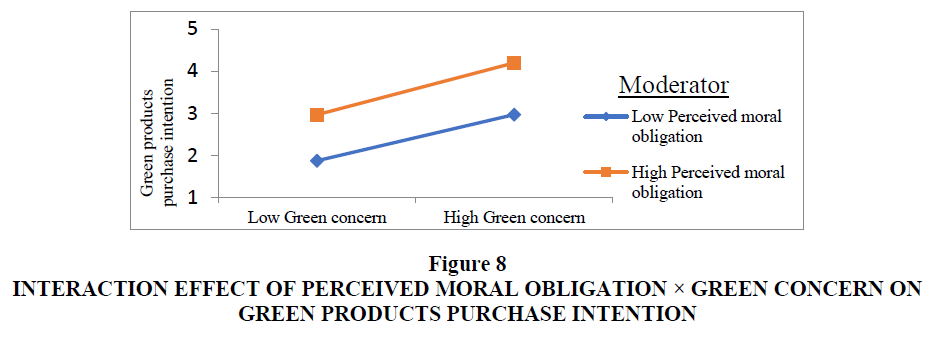Research Article: 2021 Vol: 25 Issue: 3
Impact Of Hedonic Motivation And Perceived Moral Obligation On Green Products Purchase Intention among Centennials.
Nagarajan Shanmugavel, Alagappa Institute of Management, Alagappa University
Sathish Solayan, Alagappa Institute of Management, Alagappa University
Abstract
Keywords
Green Consumerism; Hedonic Motivation; Reference Influence; Price Perception; Perceived Moral Obligation; Green Concern.
Introduction
The global catastrophic environmental challenges nudge consumers to live environment friendly and results in the increasing spate of green consumerism (Moisander, 2007). However, several problems have been identified as daunting the growth pace of green consumerism and adoption of green marketing in India (Jain & Kaur, 2004). Albeit, several studies investigated the facets of green consumerism by inheriting the Theory of Planned Behaviour (TPB) and Theory of Reasoned Action (TRA). The current research purports to explore the factors that influence the centennials towards the purchase of green products by embarking on the ‘TPB’ with the consideration of price perception, informational influence, value expressive influence and green concern; and identifies the influence of hedonic motivation and perceived moral obligation. Though several studies were conducted, the current study empirically evidences the significance of price perception on green consumerism as consumers perceive rather high price for green products (Chao & Uhagile, 2020). On the other hand, the Government of India asserted the citizens to fathom the responsibility of safeguarding the environment through all means (Tenzin Norzom, 2019). Per se, different countries experience variations in consumer attitude and behaviour (Ramachander, 1988) green consumerism among centennials in India are necessarily studied. Though India is deemed to be one of the fastest growing economies in the world 68.8 percentage of the people make their living with less than $2 a day and 30 percentage lesser than $1.25 (SOS Children’s villages Canada, n.d.) we presume price as a vital factor that needs to be studied.
The gap between intention and behaviour is ubiquitous (Ajzen & Fishbein, 2005) which can also be narrowed down by suitable factors; Peattie (2010) considered confidence generated out of the benefits derived from the environment. Similarly, several researchers considered respective factors that suit to the context; therefore, we considered perceived moral obligation and hedonic motivation as pivotal that are the mediating constructs which would bridge the gap between the intention and behaviour in the context of green consumerism in the Indian context. Centennials or Generation ‘Z’ are the one who are born during 1994-2010, digital natives; try to use technology and inclined towards economic prosperity and security (Glocal Thinking, 2016). Customers who frequently use technology are presumed to be hedonic (Qasem, 2021), centennials are technology savvy, hence centennials were considered as hedonic and from the literature they were not studied in the context of green consumerism. It was also learned that centennials would pay premium price for sustainable items (Adage, 2020) which made us to empirically test in the Indian context. Several researches have also reiterated the significance of consuming green products (Ritter et al., 2015) in the cusp of economic holocaust attributed through health and environment that have been addressed periodically through several forms. Informational influence is ascribed as the impact of messages send by peers (Wang et al., 2012), consumption experience (Hsu et al., 2006) on the attitude and behaviour of consumers had been investigated by Mi et al. (2019) alongside the value expressive influence without the construct price perception and green concern. However, few researchers state the significance of price perception on purchase intention (Chang & Wildt, 1994); and green concern was also considered as a major factor to explain the purchase intention of green products (Aman et al., 2012). Based on the discussions we proposed the following research questions (RQ).
RQ1: What are the antecedents to purchase intention of green products among the centennials?
RQ2: What is the significance of hedonic motivation among the centennials towards the purchase of green products?
RQ3: What is the importance of perceived moral obligation on the purchase intention of green products?
This study makes manifold contributions to the green consumerism literature and to facilitate the marketers in formulating realistic strategies that could be beneficial to both the consumers and green marketers. The study was organized in such way as to identify the antecedents that facilitates in nudging the consumers to purchase green products primarily. Subsequently, the effect of hedonic motivation and perceived moral obligation on the intention to purchase green products is investigated. Finally, the moderating role of gender and place of birth (rural/urban) over the intention to purchase green products is identified. The aforesaid contributions of the current study are worthy, as it synthesises knowledge that are required for the marketers to formulate strategies in nudging the consumers to buy green products that would keep away from health issues for the holistic development and sustainability of the economy. However, Sreen et al. (2018) identified the scant awareness of Indian consumers towards green products and signified the variations in gender and behaviour towards the purchase intention and no study had addressed to befit these issues. Hence, the current research intends to identify the green purchase intention of centennials as their attitude and behaviour gets varied because of their emancipation towards the use of technology (Qasem, 2021) and technology enabled platforms for their awareness and change in attitude (Kircaburun, 2020).
Further the study is presented as follows: first, the theoretical base and hypothesis is presented. Then the methodology adopted to execute the study is outlined with sample, measures, and data collection. Subsequently the results are presented, and discussions and implications are detailed. Finally, the conclusion, limitations and scope for future research is presented.
Theoretical Background and Hypotheses
Green Consumerism
In economic perspective, green consumerism is the production, marketing and consumption of goods and services that embraces environmental aspects (Akenji, 2014). However, in consumers’ perspective it is the propensity to purchase products and services that does not harm the environment. Currently the consumption of green products has become a trend among the sections of the people in India (Roshni Balaji, 2020). However, as noticed it also has become a fashion among the affluent class. Consequently, along with the established companies startups also have started manufacturing and marketing green products to lure the consumers. It is also believed that both consumers and marketers need to work holistically and take concerted efforts for sustainable environment by means of manufacturing and consumption. This forms the base for the increasing research in green consumerism. Several researchers have acquainted the concept of green marketing like green washing and green concern (Zhang et al. 2018); environmental concern (Paul et al., 2016); environmental knowledge (Maichum et al., 2016) etc. Based on the discussions relating to the growing importance of green consumerism and extant literature we proposed to have the current study.
Centennials
Centennials are the world largest demographic which who are born during 1996 – 2010 and is approximately 4.4 billion in 2020. They also represent 88 percentage of the domestic income in the emerging markets and is predicted to control 47 percentage of the global funds in 2025 (Irene Cruz Exposito, 2018). As they are the one who have good acquaintance with internet it is learned that several strategies have been designed by business house to lure them. Moreover, they are the one who need to lead the nation through cohort social media (Housand, 2016) by embracing sustainable environmental principles which is a surrogate of green consumerism. With all these inputs about the centennials we have learned that they are the apt study units whom they need to be considered for the study.
The Theory of Planned Behaviour
The Theory of Planned Behaviour (TPB) propounded by Ajzen (1985) has been robustly used by several researchers to predict the human behaviour. It has been extensively used in education (Opoku, 2020); medical psychology (Zhu, 2020); sports psychology (Chan, et al., 2020); consumer psychology (Budovska, et al., 2020); retailing (Mishra et al., 2020) and etc. Moreover, the extensive use of TPB by other researchers in green marketing (Amoako, 2020) and sustainable environment (Tonglet, 2004) ushers to adopt TPB by incorporating green concern, price perception, hedonic motivation and perceived moral obligation.
Price Perception
Price is a vital determinant of purchase decisions. In consumers perspective price is defined as the payment made by the seller to buyer in return of goods or services (Schindler & Schindler, 2011). Several researchers have argued that price is also a characterisation of use and exchange value. Generally rational consumers compare the relationship between price and performance (Voss et al., 1998). High price marks the gap between attitude and behaviour with reference to green products (Gleim et al., 2013; Joshi & Rahman, 2015).
Irrespective of the product, consumers intend to purchase products that are of low in price; however, the green products are attributed as high priced than green attributes (Eze & Ndubisi, 2013). Despite companies charge premium price for green products amidst the price sensitiveness of consumers. Centennials are socially committed and maintain the sustainability of the planet, careful in purchase decisions and concerned about quality. A recent study by (Sánchez-Bravo et al. 2020) stated that young Indian consumers were willing to pay more for sustainable products. Hence, based on these discussions from the extant literature we considered the price perception construct.
Informational Influence
Seeking others to receive information before purchasing any product is in vogue. Irrespective of the products, information provided by reliable sources would influence everyone in the purchase decision. Per se, centennials are young customers who are born in the internet age and connected to the social media networks for communication, seeking information and suggestions and to provide information and share experience. Informational influence entices the influence of individual’s attitudes and behaviours through the information disseminated by others which may be in the form of feedback, suggestions, recommendations and users’ experience (Ramos & Rodrigues, 2020). Informational influence is a surrogate construct of subjective and social norm and the information made by friends and relatives significantly influence the purchase intention (Li et al., 2015). As signified by Chen & Peng (2014) altruistic consumers seek exhaustive information about the product they purchase, however Mi et al. (2019) asserted that sometimes for ordinary commodities self-interest would also leads to purchase intention. As various researchers have differences towards the influence of information and self-interest on purchase intention, we considered this construct.
Value-Expressive Influence
Value expressiveness in the context of green consumerism is intending to purchase green products as oneself values the environment (Maio & Olson, 2000), it is also attributed as an emotional state of consumers that intrudes to transact with others in pursuit of realizing group belongingness and enables to enhance the identity for self-elevation (Li et al., 2015). Though value-expressiveness influences individuals’ brand choices to assimilate consumers with the endeared inspirational groups (Hammerl et al., 2016) as has been used by Hong & Tam (2006) in the context of intention to use mobile services, this study intends to address the centennials’ embarkment on value-expressiveness towards green products purchase intention.
Green Concern
Consumers’ awareness about environmental issues and their inclination to alleviate those issues (Akehurst et al., 2012) could be meant as green concern. Biswas and Roy (2015) identified strong positive relationships between green concern and environmental responsibility that mandates to adopt environmental-friendly behaviour. Further, consumers cannot be forced to buy green products rather their concern towards the environment nudges to buy green products and could witness a growing environmental concern among the Indian consumers (Kumar et al., 2019). Based on the discussion we felt that green concern is a subject that needs to be studied when investigating the green products purchase intention.
Hedonic Motivation
Hedonic motivation is the embodiment of fun and playfulness within an individual that could be manifested in all acts (Holbrook & Hirschman, 1982). As mentioned by O’Shaughnessy (2007) everyone possess hedonism as pleasure remains pivotal. Similarly, in the context of shopping hedonic motivation exudes creativity, novelty and sensitivity too (Solomon 2007). Further studies have also presumed that consumers possessing high hedonic motivation enthusiastically interacts and easily socializes with others while shopping (Arnold and Reynolds 2003). Similarly, with respect to the marketing aspect price is a unidimensional cue (Chang & Wildt, 1996) which may motivate, postpone or preclude purchases (Lichtenstein et al., 1993) and is also a sign of prestige. Hedonic motivation imbues within oneself affects the price perception differently for different goods. For certain goods, price posits a positive relationship with hedonism similarly, hedonic shopping value also evolves out of the supposed emotional benefits through price (Helegeson & Beatty, 1985) and presumed that paying high or low price could also be a sense of hedonic feeling (Jin et al., 2003). Further Gleim et al. (2013) poignantly stated that the price of green products influences consumers’ purchase decision. Based on the discussion we hypothesised that hedonic motivation moderates the relationship between price perception and green products purchase intention.
Similarly, information impacts the use of green products and the lack of information would create apathy towards green products (Prakash, 2002). However, in the context of online shopping the influence of informativeness was impacted by hedonism (Richard & Habibi, 2016). As no research was conducted testing the impact of hedonism on information influence and green product purchase intention our research tries to build the gap and hypothesis are formulated.
Though value-expressive influence is a momentum of adopting certain behaviours to get associated with others in pursuit of corroboration it is yet to investigate the influence of hedonic motivation on the relationship between value-expressive influence and green products purchase intention as hedonic motivation.
Perceived Moral Obligation
Perceived moral obligation is referred as personal norm or individuals’ obligation to embrace and exercise moral activities (Manstead, 2000). Green consumers exhume their conscience by means of purchasing green products that least harm the ecology (Laroche at al., 2001). Perceived moral obligation shows a stealthy relationship with informational influence, value expressiveness and green concern on green products purchase intention (Chen, 2020; Chen & Tung, 2014). In conjunction with the results of prior studiess we presumed that perceived moral norm would moderate the relationship between informational influence, value expressiveness and green concern on green products purchase intention.
Proposed Research Model and Hypotheses
It is obvious to understand that The Theory of Planned Behavior (TPB) as propounded by Ajzen (1991), has been extensively used to predict behaviour. However, Beck and Ajzen (1991) resolved that the prediction power of TPB model could be improved by the employment of perceived moral obligation, similarly new constructs could be incorporated (Han & Kim, 2010) with the erstwhile TPB model based on suitability to predict behaviours. In accordance with the suggestions of prior researchers we have added price perception, information influence, value-expressive influence and green concern. On the basis of the above discussion in the literature part and the adoption of new constructs on TPB, we introduce the theoretical model presented in Figure 1 and the following hypotheses were proposed:
H1a. Price perception shows a positive relationship with green product purchase intention.
H1b. Relationship between price perception and green product purchase intention is negatively moderated by hedonic motivation.
H1c. Relationship between price perception and green product purchase intention is positively moderated by perceived moral obligation.
H2a. Information influence directly impacts green product purchase intention.H2b. The relationship between information influence and green product purchase intention is moderated by hedonic motivation.
H2c. The relationship between information influence and green product purchase intention is positively moderated by perceived moral obligation.
H3a. Value-expressive influence shows a positive relationship with green product purchase intention.
H3b. The relationship between value-expressive influence and green product purchase intention is positively moderated by hedonic motivation.
H3c. The relationship between value-expressive influence and green product purchase intention is positively moderated by perceived moral obligation.
H4a. Green concern posits a positive relationship with green product purchase intention.
H4b. The relationship between green concern and green product purchase intention is positively moderated by hedonic motivation.
H4c. The relationship between green concern and green product purchase intention is positively moderated by perceived moral obligation.
H5. Perceived moral obligation shows a positive relationship with green products purchase intention.
Research Methodology
Design and sample
The proposed hypothetical model was validated by the employment of cross-sectional design. The required data were collected using non-probability sampling technique (judgemental sampling) to consider the study cases for our study. The study cases were met in the showrooms dealing home appliances in India with an intention to sensitize consumers about the existence and significance of green products too. Nevertheless, all the consumers were aware about the green products however their pursuit towards it were different. Though we could meet more than thousand consumers within a stint of five days in the month of January 2021 during new year sale they could not spare their time in responding to our questionnaire, hence we made it as a schedule and could get 419 responses, of which we considered 400 that sufficed to what Hair et al. (2017) recommended. The socio-demographic profile of the sample is given in Table 1
| Table 1 Demographic Characteristics of the Sample | |||
| Variable | Category | Number | Percentage |
| Gender | Male Female |
233 167 |
58.25 41.75 |
| Age | 17- 19 20-22 23-25 |
79 163 158 |
19.75 40.75 39.50 |
| Marital status | Single Married |
389 11 |
97.25 2.75 |
| Education | Arts & Science Engineering Management Medicine Others |
107 98 109 11 75 |
26.75 24.50 27.25 2.75 18.75 |
| Monthly income/pocket money | Below 10k. 11-20K 21-30k Above 31k |
114 107 82 97 |
28.50 26.75 20.50 24.25 |
| Domicile | Rural Urban |
207 193 |
51.75 48.25 |
| Sources of green product information | TV advertisements Social Media Advertisements Sales People Teachers Doctors |
61 127 29 135 48 |
15.25 31.75 7.25 33.75 12 |
Measures
The survey instrument (schedule consists) of seven constructs with 21 items. In order to fulfil the objectives of the study all the measures that are validated through prior studies were taken into consideration for the current research. Similarly, the items to every construct were measured on Likert’s seven-point scale that ranges between 1 (strongly disagree) to 7 (strongly agree). Based on the suitability of the context all items were modified and inputs were sought from academicians, customers and marketers. In line with prior researchers as demographic details of the study cases shows significance, we included those questions and their basic understanding about green products were also recorded. All the sample cases were well aware about green products and also had purchase else. The source of constructs and its items are shown in Appendix A.
Data Analysis
The current research used Microsoft Excel, SPSS 23.0 version and AMOS to analyze the data. As suggested by Anderson and Gerbing (1998) we employed the two-step structural equation modelling (SEM) approach to study the proposed hypotheses. As part of the SEM initially we used confirmatory factor analysis (CFA) and further the validity and reliability of constructs and items and the essential model fit indices were also checked. Subsequently the structural model evaluation was made. Further based on the suggestions made by Baron & Kenny (1986) we have tested the moderation effect of hedonic motivation and perceived moral obligation on the relationship between independent constructs that are the antecedents to green product purchase intention. The proposed hypothetical framework has been presented in Appendix B.
Results
Demographic Profile of the Respondents
The demographic profile of the study cases is presented in Table 1. The study consists of 58.25 % male and 41.75 % female. The age of the centennials was further segregated into three categories and shows that 40.75 % of the respondents age is between 20-22 and 19.75 respondents is between 17-19. As female respondents are included in the study 2.75% of them are married. Further the respondents were classified based on education and shows that 27.25 % of the respondents undergo management courses, 26.75% pursue arts and science courses and 24.50 % of the respondents pursue engineering courses. As income is also a major factor that facilitates buying the respondents’ income or pocket money were investigated and discerned that 28.50 % of the respondents’ income/pocket money is below INR 10k. and 26.75 % of respondents have income or pocket money between INR. 11,000 and 20,000. Similarly, the domicile of the respondents was considered and 51.25% are residing in rural areas. Further, teachers and social media claim a major share in the provision of information about green products.
Assessment of Measurement Model
Initially the reliability and validity (convergent and discriminant) of the constructs are measured and is presented in Table 2. All the constructs hold a good measure of content and convergent validity as the item loadings are above 0.76 and the values of average variance extracted (AVE) for all the constructs above 0.50. In accordance with the proposition of Hew and kadir (2016) the threshold level for the discriminant validity is met as the AVE values are higher than maximum shared variance (MSV) and average shared variance (ASV). Similarly, all the latent variables gain above 0.87 as composite reliability and the value of Cronbach's alpha exceeds the threshold value as ranges between 0.75 to 0.89 (Nunnally & Bernstein, 1994). Subsequently, Table 3 tests the discriminant validity through the correlation matrix. The diagonal values in Table 3 merely represent the square root of AVE's. The square roots of the AVE values are higher than their respective intercorrelations and discriminant validity is confirmed. Thus in lieu of the above discussions the measurement model exhibits required levels of validity and reliability. Finally, in line with the recommendations of Leong et al. (2019) and others to assess the uni-dimensionality and minimising the measurement bias the values of the essential fit indices were calculated and are more than the threshold values such as; (CMIN/df = 2.057, goodness-of-fit index (GFI) = 0.936, comparative fit index (CFI) = 0.971, and root mean square error of approximation (RMSEA) = 0.049.
| Table 2 Results of Measurement Model | |||||
| Construct | Items | Mean (SD) | Loadings | AVE, MSV & ASV | Composite reliability |
| Price perception | PP1 PP2 PP3 |
4.5 (1.5) 4.5 (1.4) 4.4 (1.3) |
0.842*** 0.894*** 0.837*** |
0.736, 0.515 & 0.333 | 0.874 |
| Informational influence | II1 II2 II3 |
4.2 (1.3) 4.2 (1.2) 4.3 (1.3) |
0.797*** 0.793*** 0.895*** |
0.688, 0.513 & 0.386 | 0.869 |
| Value expressive influence | VEI1 VEI2 |
4.1 (1.3) 3.8 (1.3) |
0.859*** 0.856*** |
0.735, 0.634 & 0.405 | 0.847 |
| Green concern | GC1 GC2 GC3 GC4 |
3.9 (1.3) 3.8 (1.2) 3.8 (1.3) 3.8 (1.3) |
0.768*** 0.790*** 0.902*** 0.844*** |
0.685, 0.476 & 0.339 | 0.897 |
| Hedonic motivation | HM1 HM2 HM3 |
3.5 (1.5) 3.7 (1.4) 3.6 (1.3) |
0.870*** 0.850*** 0.833*** |
0.724, 0.637 & 0.342 | 0.887 |
| Perceived moral obligation | PMO1 PMO2 PMO3 |
3.6 (1.4) 3.7 (1.3) 3.6 (1.4) |
0.825*** 0.816*** 0.864*** |
0.698, 0.637 & 0.416 | 0.874 |
| Green product purchase intention | GPI1 GPI2 GPI3 |
3.9 (1.3) 3.8 (1.3) 3.7 (1.2) |
0.878*** 0.833*** 0.844*** |
0.726, 0.473 & 0.416 | 0.888 |
| Table 3 Inter-Correlation and √Ave Values | ||||||||
| Constructs | Cronbach’s α | PMO | PP | II | VEI | GC | HM | GPI |
| PMO | 0.872 | 0.835 | ||||||
| PP | 0.891 | 0.491 | 0.858 | |||||
| II | 0.869 | 0.530 | 0.716 | 0.830 | ||||
| VEI | 0.848 | 0.796 | 0.504 | 0.613 | 0.858 | |||
| GC | 0.896 | 0.499 | 0.588 | 0.690 | 0.578 | 0.828 | ||
| HM | 0.886 | 0.798 | 0.480 | 0.510 | 0.657 | 0.395 | 0.851 | |
| GPI | 0.886 | 0.676 | 0.644 | 0.643 | 0.632 | 0.688 | 0.581 | 0.852 |
Analysis of Common Method Bias (CMB)
Prior researchers as stated the possibilities of common method variance in the employment of a structured survey instrument that might hamper the predispositions of the respondents Harman’s single factor (Wong et al., 2015) analysis was employed and learned that a single factor claimed only 31.82 % of total variance extracted which lesser than the stated 50 % and confirmed the study free from CMB (Hew & Kadir, 2016).
Evaluation of Structural Model
The results of the hypothesis testing are presented in Table 4. Per se, the relationship between price perception and green products purchase intention was discerned as statistically significant (β = 0.272; p<0.001), thereby the study supports H1a. Similarly, H1b got accepted as Hedonic motivation negatively moderates the relationship between price perception and green products purchase intention with (β = -0.152; p<0.001). Correspondingly, H1c got accepted as perceived moral obligation positively moderates the relationship between price perception and green products purchase intention with (β=0.205; p<0.001). However, statistical significance could not be derived for H2a whereby information influence does not impact green product purchase intention. In contrast the relationship between information influence and green product purchase intention was moderated by hedonic motivation (β = 0.417; p<0.001) and H2b got accepted. Similarly, the relationship between information influence and green product purchase intention was moderated by perceived moral obligation (β = 0.385; p < 0.001) whereby H2c got accepted. Next, value expressive influence posits a significant relationship with green product purchase intention (β = 0.552; p < 0.001) thus H3a got accepted. The effect of hedonic motivation significantly influences the relationship between value expressive influence and green product purchase intention (β = 0.388; p < 0.001), whereby accepting H3b. Consistently, H3c got accepted (β = 0.205; p < 0.001) and perceived moral obligation demonstrated a moderating effect between value expressive influence and green product purchase intention. Next, statistical significance could be discerned between green concern and green product purchase intention (β = 0.337; p < 0.001) and H4a got accepted. Further, in investigating the moderating effect of hedonic motivation and perceived moral obligation between green concern and green products purchase intention the derived coefficients are (β = 0.227; p < 0.001) and (β = 0.338; p < 0.001) that support H4b and H4c. Finally, H5 got accepted (β = 0.427; p < 0.001), whereby statistical significance could be derived between perceived moral obligation and green products purchase intention. Also, the coefficient of determination (r2) values for price perception, information influence, value expressive influence, green concern and green product purchase intention derive are 0.231, 0.269, 0.619, 0.305 and 0.555 respectively. The interaction graphs given in Appendix B exhibits the moderation effects in Table 4.
| Table 4 Results of Hypothesis Testing | |||
| Hypotheses | Endogenous constructs | Exogenous constructs | Path coefficient |
| Hypothesis 1a | Green products purchase intention | Price perception | 0.272*** |
| Hypothesis 1b | Green products purchase intention | Price perception x Hedonic motivation | -0.152*** |
| Hypothesis 1c | Green products purchase intention | Price perception×perceived moral obligation | 0.205*** |
| Hypothesis 2a | Green products purchase intention | Information influence | 0.070ns |
| Hypothesis 2b | Green products purchase intention | Information influence×hedonic motivation | 0.417*** |
| Hypothesis 2c | Green products purchase intention | Information influence×perceived moral obligation | 0.385*** |
| Hypothesis 3a | Green products purchase intention | Value expressive influence | 0.552*** |
| Hypothesis 3b | Green products purchase intention | Value expressive influence×Hedonic motivation | 0.388*** |
| Hypothesis 3c | Green products purchase intention | Value expressive influence×perceived moral obligation | 0.413*** |
| Hypothesis 4a | Green products purchase intention | Green concern | 0.337*** |
| Hypothesis 4b | Green products purchase intention | Green concern×Hedonic motivation | 0.227** |
| Hypothesis 4c | Green products purchase intention | Green concern×perceived moral obligation | 0.328** |
| Hypothesis 5 | Green products purchase intention | perceived moral obligation | 0.427*** |
Discussion
Although prior researches had suggested the significant impact of reference influence towards purchase intention, no research has explored the moderating effect of hedonic motivation and perceived moral obligations towards green products purchase intention. However, these two variables significantly impact green purchase intentions (Choi & Johnson, 2019; Chen, 2020). Hence in conjunction with the objectives of the study by the employment of these two factors we have generated the following findings. First, the study identifies the significant relationship between price perception and green products purchase intention which is consistent with the findings of Chao & Uhagile (2020). It shows that price is compatible with the benefits that consumers derive from the green products. Despite the scarce empirical evidence investigating hedonic motivation on purchase behaviour of green products (Oliver & Rosen, 2010) our study validated hedonic motivation with green product purchase and hedonic motivation negatively moderates the relationship between price perception and green products purchase intention that corroborates with Tripathi & Pandey (2019). This shows that consumers though possess hedonism stick to value for money and grab utmost benefits from green products. Another poignant finding that has been derived from the study is in contrast with Ramos & Rodrigues (2020), because mere information about green products in any form does not usher the centennials to buy rather, they should sway with hedonic motivation and possess moral obligation. In contrast value expressive influence and green concern posits a positive relationship with green product purchase intention in line with Maio & Olson (2000) and Biswas and Roy (2015), because centennials are skewed to purchase green products as they value the environment and embraces green concern. Hedonism devises significant impact and strengthens the relationship between reference influence (exempting price perception); green concern and green products purchase intention. This shows that hedonic motivation activates information influence, value expressiveness, and green concern those are originally imbued within the centennials as they are born in the information and technology era and insinuate as a significant factor that ushers them to purchase green products.
Next, the study finds a close relationship between perceived moral obligation and green products purchase intention that insinuate that centennials who originally have moral obligation intends to buy green products in understanding the health and environmental impacts of green products. Similarly, the influence of perceived moral obligation was tested on the relationships between reference influence; green concern and green products purchase intention. The findings of our study were in corroboration with Hwang et al. (2015). Nevertheless, in the context of green consumerism, validation to the constructs of reference influence is novel and the price perception, information influence, value expressive influence and green concern are sensitized by the influence of perceived moral obligation. It shows that perceived moral obligation significantly impacts green products purchase intention either directly or on the other factors that influences green products purchase intention.
The above discussions related to the moderating effect of hedonic motivation and perceived moral obligation beams new insights to the literature on green consumerism. Holistically, the results scuttles sensitized and altruistic discussion for marketers to look into the influence of hedonic motivation and enabling perceived moral obligation of the consumers to promote green products.
Theoretical Contributions
As developing countries experience a momentous shift in green consumption Lee (2008) because of the sensitization towards sustainable environment Kim et al. (2012) the current empirical research would offer poignant and notable contributions for a realistic academic understanding of centennials’ green products purchase behaviour. The outcome of this research add new knowledge to the green consumerism literature in understanding the significance of centennials’ hedonic motivation, perceived moral obligation and further by investigating and validating the factors of reference influence and green concern towards green products purchase. Price perception is noted as one of the key variables and a strong predictor to green products purchase intention. Contradictory, information influence does not show a significant impact towards green products purchase though centennials are sufficed with unbridled and realistic information about green products. However, information influence when moderated by moral obligation activates centennials towards green products and remains an interesting and novel finding, which adds to the extant literature on green consumerism. Another important contribution of this study is the moderating impact of hedonism, though hedonism is presumed to be a ubiquitous character imbued among the centennials as they are techno-savvy. Similarly perceived moral obligation shape the consumers between reference influence and green purchase intention.
Implications for Practice
Inimitable findings derived from the current study offers valuable inputs that could facilitate green marketers. Kindling consumers through cascading green product information (Bonini & Oppenheim, 2008), educating the imminent need for green consumerism (Kim et al., 2012), promotional strategies for green products (Gleim et al., 2013) and increasing the availability of green products (Nguyen et al. 2019) though contributes significantly towards green consumerism our study recommends to befit the needs of the centennials by offering green product information that would trigger the hedonic nature fettered within the centennials. As the centennials are born between 1995 and 2010, they are tech savvy and individuals who use technology quite often are hedonic in nature (Qasem, 2021), hence from the research we intend to instigate the marketers in tapping the unbridled market potential shrouded with the centennials. Further, from one of the research findings as majority of centennials were aware about green products through teachers and physicians, marketers are scuttled to design marketing communication campaigns with due diligence incorporating the roles of teachers and physicians as they create moral obligation (Lumpkin, 2008) towards the environment rather than social media platforms. Though younger people are impulsive than older ones (Chopdar & Balakrishnan, 2020), it is left with the marketers to make them rational and sinuate green concern. Hence, it is imperative for the green marketers to augment hedonic and moral obligation among the centennials.
Limitations and Directions for Future Research
Though our research significantly contributes to the literature of green consumerism it is mot exempted from inherent limitations. First, the data required for the study was collected from a particular segment which would lead to common method bias hence, with the inputs from Podsakoff et al. (2003) the items of independent variables were sequenced first and subsequently for the dependent variables. Next, the study design as originally cross-sectional in nature could not highlight the causal relationships hence, longitudinal studies are suggested to be conducted to explain realistic actionable findings. Further, in addition with the moderating effect of study constructs gender and domicile could be done as demographic variables play significant roles in any purchase decisions. In addition to hedonic motivation and perceived moral obligation new study constructs that could be specifically made on centennials could be studied.
Conclusion
Globally as consumers are sensitized towards the use of green products, this study attempts to study the underlying factors that trigger the centennials towards the purchase of green products. In lieu of the literature reviewed the current research is the first to employ two contrast constructs such as hedonic motivation that is fettered with centennials (Qasem, 2021) and perceived moral obligation is an attribute that is high with middle aged and old age people as supposed by (Rathore & Sarmah, 2021). Similarly, this is one of an important area of study as consumers, marketers and government holistically work towards sustainable environment by means of green consumerism. While looking into the novelty aspect of the research, constructs from reference influence has been mended with price perception and green concern subsequently the moderating effect of hedonic motivation and perceived moral obligation of centennials. In view of the worthy and poignant findings and the resultant discussions academicians, practitioners and all the stakeholders would be nudged to explore the significant ways of enhancing green consumerism among the centennials in the future.
Funding
This study has been conducted by the grant received from UGC STRIDE Component -I Alagappa University, Karaikudi, sanctioned vide Letter No. F. 2-5/2019 (STRIDE-I), Dt.03.12.2019".
| Appendix A Constructs, Indicators, and Sources | ||
| Construct | Item | Sources |
| Price perception | The price of the green product is appropriate relative to its nature The price of the green product meets my expectations The price of the green product is good value for money comparing to normal products |
Herrmann, A., Xia, L., Monroe, K. B., & Huber, F. (2007). |
| Information influence | I will obtain information about green product from friends and family. I will buy green products which comes along with pertinent certification marks. I will refer to the choice of professionals and experts to buy green products |
Park and Lessig (1977); Wang (2013) |
| Value expressive influence | I will consider the status of the brand or behavior before consumption. Buying green products that are renowned in the market will be appreciated or respected by others. |
Park and Lessig (1977); Wang (2013) |
| Green concern | I am extremely worried about the worsening state of environment The environment is a major concern for me and should be for everyone I must bother about the egregious environmental issues I often think about how the condition of the environment could be improved |
Lee (2008) and Paladino and Ng (2013) |
| Hedonic motivation | It is a pleasure for me in seeking information about green products It is an entertainment for me to buy and experience green products I enjoy buying and experiencing either green products available in the market |
(Venkatesh et al (2012) |
| Perceived moral obligation | I am obliged to purchase green products as it reduces environmental issues. I purchase green products as it enhances sustainable environment Everybody should purchase green products as we can only protect the environment |
Brody, Grover, and Vedlitz (2012) |
| Green products purchase intention | I like to purchase green products When purchasing new products of any kind my first priority will be towards green products I advocate others to purchase green products |
Chang and Chen (2008) |
Appendix B
Figure 1 Interaction Effect of Hedonic Motivation × Price Perception on Green Products Purchase Intention
Figure 2 Interaction Effect of Perceived Moral Obligation × Price Perception on Green Products Purchase Intention
Figure 3 Interaction Effect of Hedonic Motivation × Information Influence on Green Products Purchase Intention
Figure 4 Interaction Effect of Perceived Moral Obligation × Information Influence on Green Products Purchase Intention
Figure 5 Interaction Effect of Hedonic Motivation × Value Expressive Influence on Green Products Purchase Intention
Figure 6 Interaction Effect of Perceived Moral Obligation × Value Expressive Influence on Green Products Purchase Intention
Figure 7 Interaction Effect of Hedonic Motivation × Green Concern on Green Products Purchase Intention
Figure 8 Interaction Effect of Perceived Moral Obligation × Green Concern on Green Products Purchase Intention
References
- Adage. (2020). Generation Z is willing to pay more for Eco-friendly products. https://adage.com/article/cmo-strategy/generation-z-willing-pay-more-eco-friendly-products.
- Ajzen, I. (1991). The theory of planned behavior. Organization Behaviour and Human Decision Process. 50 (2), 179–211.
- Ajzen, I., & Fishbein, M. (2005). The influence of attitudes on behavior.
- Akehurst, G., Afonso, C., & Martins Gonçalves, H. (2012). Re-examining green purchase behaviour and the green consumer profile: new evidences. Management Decision. 50 (5), 972-988.
- Aman, A.L., Harun, A., & Hussein, Z. (2012). The influence of environmental knowledge and concern on green purchase intention the role of attitude as a mediating variable. British Journal of Arts and Social Sciences, 7(2), 145-167.
- Amoako, G. K., Dzogbenuku, R.K., & Abubakari, A. (2020). Do green knowledge and attitude influence the youth's green purchasing? Theory of planned behavior. International Journal of Productivity and Performance Management.
- Anderson, J.C., & Gerbing, D.W. (1988). Structural equation modeling in practice: A review and recommended two-step approach. Psychological Bulletin, 103(3), 411.
- Arnold, M.J., & Reynolds, K.E. (2003). Hedonic shopping motivations. Journal of Retailing, 79(2), 77-95.
- Baron, R.M., & Kenny, D.A. (1986). The moderator-mediator variables distinction in social psychological research: Conceptual, strategic and statistical consideration. Journal of Personality and Social Psychology, 51, 1173-1182.
- Beck, L., & Ajzen, I. (1991). Predicting dishonest actions using the theory of planned behavior. Journal of Research in Personality, 25, 285–301.
- Biswas, A., Roy, M., (2015). Green products: an exploratory study on the consumer behaviour in emerging economies of the East. Journal of Cleaner Production. 87, 463-468.
- Bonini, S., & Oppenheim, J. (2008). Cultivating the green consumer. Stanford Social Innovation Review, Fall, 56–61.
- Budovska, V., Torres Delgado, A., & Øgaard, T. (2020). Pro-environmental behaviour of hotel guests: Application of the Theory of Planned Behaviour and social norms to towel reuse. Tourism and hospitality research, 20(1), 105-116.
- Chan, D.K.C., Zhang, L., Lee, A.S.Y., & Hagger, M.S. (2020). Reciprocal relations between autonomous motivation from self-determination theory and social cognition constructs from the theory of planned behavior: A cross-lagged panel design in sport injury prevention. Psychology of Sport and Exercise, 48, 101660.
- Chang, T.Z., & Wildt, A.R. (1994). Price, product information, and purchase intention: An empirical study. Journal of the Academy of Marketing science, 22(1), 16-27.
- Chang, T-Z., & Wildt, A.R. (1996). Impact of product information on the use of price as a quality cue. Psychology and Marketing, 13(1), 55-75.
- Chao, E., & Uhagile, G.T. (2020). Consumer Perceptions and Intentions Toward Buying Green Food Products: A Case of Tanzania. Journal of International Food & Agribusiness Marketing, 1-16.
- Chen, M.F. (2020). The impacts of perceived moral obligation and sustainability self‐identity on sustainability development: A theory of planned behavior purchase intention model of sustainability‐labeled coffee and the moderating effect of climate change skepticism. Business Strategy and the Environment, 29(6), 2404-2417.
- Chen, M.F., & Tung, P.J. (2014). Developing an extended theory of planned behavior model to predict consumers’ intention to visit green hotels. International Journal of Hospitality Management, 36, 221-230.
- Choi, D., & Johnson, K.K. (2019). Influences of environmental and hedonic motivations on intention to purchase green products: An extension of the theory of planned behavior. Sustainable Production and Consumption, 18, 145-155.
- Chopdar, P.K., & Balakrishnan, J. (2020). Consumers response towards mobile commerce applications: SOR approach. International Journal of Information Management, 53, 102-106.
- Eze, U.C., & Ndubisi, N.O. (2013). Green Buyer Behavior: Evidence from Asia Consumers. Journal of Asian and African Studies, 48(4), 413-426.
- Gleim, M. R., Smith, J.S., Andrews, D., & Cronin, J.J. (2013). Against the green: A multi‐method examination of the barriers to green consumption. Journal of Retailing, 89(1), 44–61.
- Glocal Thinking. (2016). Millennials vs. Centennials: shared characteristics, differences and challenges to consider. https://www.glocalthinking.com/en/millennials-vs-centennials.
- Hair, J. F., Hult, G.T.M., Ringle, C.M., Sarstedt, M., & Thiele, K.O. (2017). Mirror, mirror on the wall: A comparative evaluation of composite-based structural equation modeling methods. Journal of the Academy of Marketing Science, 45(5), 616–632.
- Hammerl, M., Dorner, F., Foscht, T., & Brandstätter, M. (2016). Attribution of symbolic brand meaning: the interplay of consumers, brands and reference groups. Journal of Consumer Marketing. 33(1), 32-40.
- Han, H., & Kim, Y. (2010). An investigation of green hotel customers’ decision formation: Developing an extended model of the theory of planned behavior. International Journal of Hospitality Management, 29(4), 659-668.
- Helgeson, J.G., & Beatty, S.E. (1985). An information processing perspective on the internalization of price stimuli. Advances in Consumer Research. 12, 91-96.
- Hew, T.S., & Kadir, S.L.S.A. (2016). Understanding cloud-based VLE from the SDT and CET perspectives: Development and validation of a measurement instrument. Computers & Education, 101, 132–149.
- Holbrook, M.B., & Hirschman, E.C. (1982). The experiential aspects of consumption: Consumer fantasies, feelings, and fun. Journal of Consumer Research, 9(2), 132-140.
- Hong, S.J., & Tam, K.Y. (2006). Understanding the adoption of multipurpose information appliances: The case of mobile data services. Information Systems Research, 17(2), 162-179.
- Housand, A. (2016). CENTENNIALS: The World is Waiting!. parenting for high potential, 5(2), 6.
- Hwang, C.G., Lee, Y.A., & Diddi, S. (2015). Generation Y's moral obligation and purchase intentions for organic, fair-trade, and recycled apparel products. International Journal of Fashion Design, Technology and Education, 8(2), 97-107.
- Irene Cruz Exposito. (2018). Centennials, the generation that has never known the world without internet. https://www.bbva.com/en/centennials-generation-never-known-world-internet/
- Jain, S. K., & Kaur, G. (2004). Green Marketing: An Indian Perspective. Decision (0304-0941), 31(2).
- Jin, B., Sternquist, B., & Koh, A. (2003). Price as hedonic shopping. Family and Consumer Sciences Research Journal, 31(4), 378-402.
- Joshi, Y., & Rahman, Z. (2015). Factors affecting green purchase behaviour and future research directions. International Strategic management review, 3(1-2), 128-143.
- Kim, S.Y., Yeo, J., Sohn, S.H., Rha, J.‐y., Choi, S., Choi, A.Y., & Shin, S. (2012). Toward a composite measure of green consumption: An exploratory study using a Korean sample. Journal of Family and Economic Issues, 33(2), 199-214.
- Kircaburun, K., Alhabash, S., Tosuntaş, Ş.B., & Griffiths, M.D. (2020). Uses and gratifications of problematic social media use among university students: A simultaneous examination of the Big Five of personality traits, social media platforms, and social media use motives. International Journal of Mental Health and Addiction, 18(3), 525-547.
- Kumar, R., Saha, R., Sekar, P.C., & Dahiya, R. (2019). Examining the role of external factors in influencing green behaviour among young Indian consumers. Young Consumers. 20(4), 380-398.
- Laroche, M., Bergeron, J., & Barbaro-Forleo, G. (2001). Targeting consumers who are willing to pay more for environmentally friendly products. Journal of Consumer Marketing, 18, 503–520.
- Lee, K. (2008). Opportunities for green marketing: Young consumers. Marketing Intelligence and Planning, 26(6), 573-586.
- Leong, L.Y., Hew, T.S., Ooi, K.B., & Lin, B. (2019). Do electronic word-of-mouth and elaboration likelihood model influence hotel booking? Journal of Computer Information Systems, 59(2), 146–160.
- Li, G., Bai, K., Liu, X., 2015. The influence of reference groups on the conformity behavior of overseas shopping by Chinese tourists. Resources Science 37 (11), 2151–2161.
- Lichtenstein, D.R., Ridgway, N.M., & Netemeyer, R.G. (1993). Price perceptions and consumer shopping behavior: Afield study. Journal of Marketing Research, 30(2), 234- 245.
- Lumpkin, A. (2008). Teachers as role models teaching character and moral virtues. Journal of Physical Education, Recreation & Dance, 79(2), 45-50.
- Maichum, K., Parichatnon, S., & Peng, K. C. (2016). Application of the extended theory of planned behavior model to investigate purchase intention of green products among Thai consumers. Sustainability, 8(10), 1077.
- Maio, G.R., & Olson, J.M. (2000). What is a “value-expressive” attitude. Why we evaluate: Functions of attitudes, 249-269.
- Manstead, A.S. (2000). The role of moral norm in the attitude–behavior relation.
- Mi, L., Zhu, H., Yang, J., Gan, X., Xu, T., Qiao, L., & Liu, Q. (2019). A new perspective to promote low-carbon consumption: The influence of reference groups. Ecological Economics, 161, 100-108.
- Mishra, R., Singh, R.K., & Koles, B. (2020). Consumer decision‐making in Omnichannel retailing: Literature review and future research agenda. International Journal of Consumer Studies.
- Moisander, J. (2007). Motivational complexity of green consumerism. International journal of consumer studies, 31(4), 404-409.
- Nath, V., Kumar, R., Agrawal, R., Gautam, A., & Sharma, V. (2012). Green behaviors of Indian consumers. International journal of research in management, Economics and Commerce, 2(11), 488-498.
- Nguyen, H.V., Nguyen, C.H., & Hoang, T.T.B. (2019). Green consumption: Closing the intention‐behavior gap. Sustainable Development, 27(1), 118-129.
- Nunnally, J. C., & Bernstein, I. H. (1994). Psychometric theory (3rd ed.). New York: McGraw-Hill.
- O’Shaughnessy, J., & O’Shaughnessy, N. J. (2007). Marketing, the consumer society and hedonism. European Journal of Marketing, 35(5/6), 524–547.
- Oliver, J.D., & Rosen, D.E. (2010). Applying the environmental propensity framework: A segmented approach to hybrid electric vehicle marketing strategies. Journal of Marketing Theory and Practice, 18(4), 377-393.
- Opoku, M.P., Cuskelly, M., Pedersen, S.J., & Rayner, C.S. (2020). Applying the theory of planned behaviour in assessments of teachers’ intentions towards practicing inclusive education: A scoping review. European Journal of Special Needs Education, 1-16.
- Paul, J., Modi, A., & Patel, J. (2016). Predicting green product consumption using theory of planned behavior and reasoned action. Journal of Retailing and Consumer Services, 29, 123-134.
- Peattie, K. (2010). Green consumption: Behavior and norms. Annual Review of Environment and Resources, 35(1), 195–228.
- Prakash, A. (2002). Green marketing, public policy and managerial strategies. Business Strategy and the Environment, 11(5), 285-297.
- Qasem, Z. (2021). The effect of positive TRI traits on centennials adoption of try-on technology in the context of E-fashion retailing. International Journal of Information Management, 56, 102254.
- Ramachander, S. (1988). Consumer behaviour and marketing: towards an Indian approach?. Economic and Political Weekly, 22-25.
- Ramos, C.M., & Rodrigues, J.M. (2020, July). The Influence of Social Networking Technology on Centennials Purchase Intent. In International Conference on Human-Computer Interaction (pp. 451-465). Springer, Cham.
- Rathore, P., & Sarmah, S. P. (2021). Investigation of factors influencing source separation intention towards municipal solid waste among urban residents of India. Resources, Conservation and Recycling, 164, 105164.
- Richard, M.O., & Habibi, M.R. (2016). Advanced modeling of online consumer behavior: The moderating roles of hedonism and culture. Journal of Business Research, 69(3), 1103-1119.
- Ritter, Á.M., Borchardt, M., Vaccaro, G.L., Pereira, G.M., & Almeida, F. (2015). Motivations for promoting the consumption of green products in an emerging country: exploring attitudes of Brazilian consumers. Journal of Cleaner Production, 106, 507-520.
- Roshni Balaji. (2020). Five shopping trends promoting a new wave of green consumerism in India. https://yourstory.com/socialstory/2020/02/shopping-trends-eco-friendly-shopping-consumerism
- Sánchez-Bravo, P., Chambers, V. E., Noguera-Artiaga, L., Sendra, E., Chambers IV, E., & Carbonell-Barrachina, Á. A. (2020). Consumer understanding of sustainability concept in agricultural products. Food Quality and Preference, 104136.
- Schindler, R.M., & Schindler, R. (2011). Pricing strategies: a marketing approach. sage.
- Solomon, M.R. (2007). Motivation and values. Consumer Behavior. Buying, Having, and Being. Upper Saddle River, NJ: Pearson Prentice Hall, 152-191.
- SOS Children’s villages CANADA. (n.d.). Poverty in India: Facts and Figures on the Daily Struggle for Survival. https://www.soschildrensvillages.ca/news/poverty-in-india-602.
- Sreen, N., Purbey, S., & Sadarangani, P. (2018). Impact of culture, behavior and gender on green purchase intention. Journal of Retailing and Consumer Services, 41, 177-189.
- Tenzin Norzom. (2019). These 5 initiatives by the Modi government are a step towards a green India. https://yourstory.com/2019/08/modi-government-initiatives-environment-schemes-green-india?
- Tonglet, M., Phillips, P.S., & Read, A.D. (2004). Using the Theory of Planned Behaviour to investigate the determinants of recycling behaviour: a case study from Brixworth, UK. Resources, conservation and recycling, 41(3), 191-214.
- Tripathi, A., & Pandey, N. (2019). Promotional framing of green products: Mediating role of sale proneness. Journal of Promotion Management, 25(7), 983-1008.
- Voss, G.B., Parasuraman, A., & Grewal, D. (1998). The roles of price, performance, and expectations in determining satisfaction in service exchanges. Journal of marketing, 62(4), 46-61.
- Wang, X., Yu, C.L., & Wei, Y.J. (2012). Social media peer communication and impacts on purchase intentions: A consumer socialization framework. Journal of Interactive Marketing, 26, 198–208.
- Wong, C.H., Tan, G.W.H., Tan, B.I., & Ooi, K.B. (2015). Mobile advertising: The changing landscape of the advertising industry. Telematics and Informatics, 32(4), 720–734.
- Zhang, L., Li, D., Cao, C., & Huang, S. (2018). The influence of greenwashing perception on green purchasing intentions: The mediating role of green word-of-mouth and moderating role of green concern. Journal of Cleaner Production, 187, 740-750.
- Zhu, G., Qian, X., Qi, L., Xia, C., Ming, Y., Zeng, Z., ... & Zhang, H. (2020). The intention to undertake physical activity in pregnant women using the theory of planned behaviour. Journal of Advanced Nursing.
